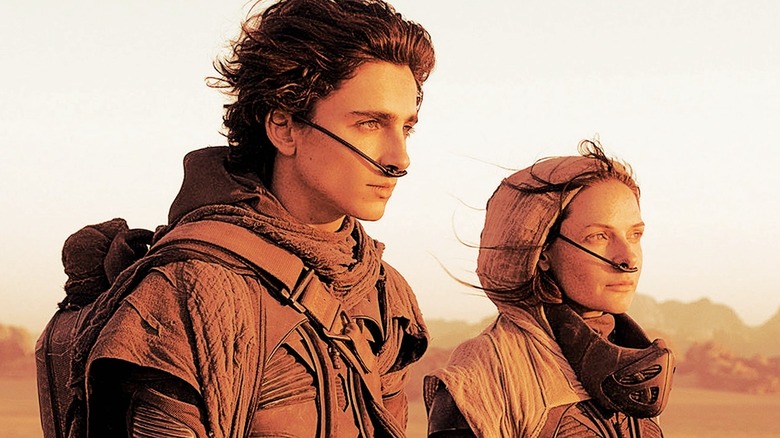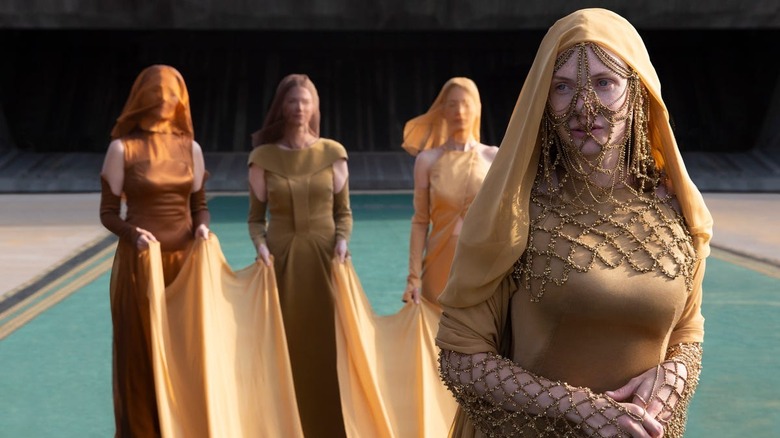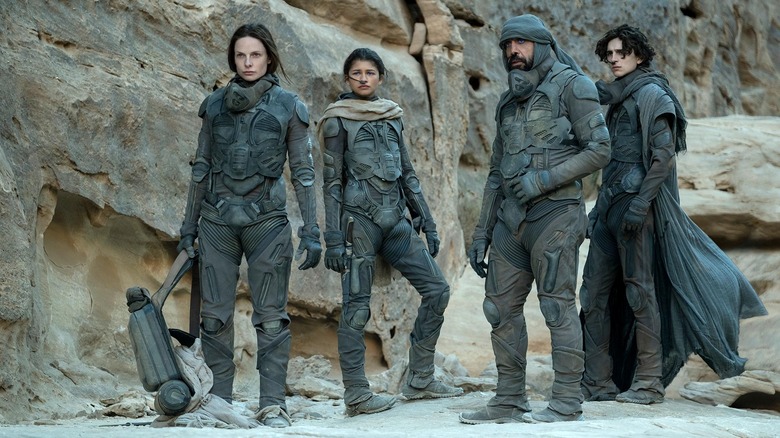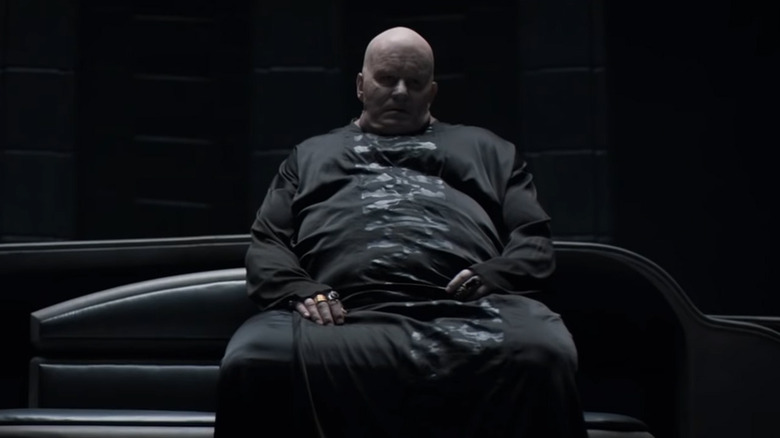Dune Costume Designer Jacqueline West On How To Make A Stillsuit [Interview]
"Dune" costumer designer Jacqueline West is one of the best in the business. The three-time Academy Award nominee's previous credits include "Argo," "The Curious Case of Benjamin Button," "The Revenant," and "The Social Network." She's also frequently collaborated with Terrence Malick, having worked on "The New World" and "The Tree of Life," to name a few. It's a long list of accomplishments, including Martin Scorsese's next film, "The Killers of the Flower Moon."
West has brought accuracy and life to several different time periods captured on screen. Even though "Dune" is set in the future, she still found herself going back to the past — drawing on medieval times, the Templars, and iconic films such as "Apocalypse Now" and "Lawrence of Arabia." When West was first approached for the Frank Herbert adaptation, she told director Denis Villeneuve she'd never done a futuristic project, which is why her eye (along with co-costume designer Bob Morgan) was perfect for the film.
'The most expensive costume ever made.'
You were looking at medieval times for "Dune," right?
Absolutely. In fact, early on, I claimed a term, which Denis loved, I called it "modieval." It was a modern take on the medieval. I felt "Dune" is a world starting over and Denis didn't want typical sci-fi futuristic clothes. He wanted something grounded in the past, but a future and a new future, like a world starting over. I thought I would go to the past for that, and then streamline it in a way that it looks both modern, but has the simplicity of medieval clothing.
Say for the medieval gown Lady Jessica wears when she arrives on Arrakis, how'd you modernize it?
It was kind of based on a woman's armor, but I wanted to always give her a very numb look because she is a Bene Gesserit. I thought that keeping her shapes and silhouettes rather nun-like would be very apropos, but she's also a concubine. She needed a bit of sexuality in her wardrobe. I kept it very close to the body, but I took a lot of shapes from Giotto paintings, french nuns in the paintings of Giotto.
The chains were difficult to pull off, right?
Well, the chain, as you probably have heard, we called it the most expensive costume ever made. We had an incredible fabricator who worked on it. Most of the movies, she worked on that chain on a mannequin head mold, Rebecca Ferguson, and she painstakingly made each link fall perfectly to fit her bone structure and get cheekbones and go around her mouth perfectly and then bleed down to her shoulders to her arms. It was quite a process.
It became so tedious. I thought it would never be finished and sure enough, about a week before they left the spaceship, it was done. We put it on Rebecca to fit her perfectly and she loved it. I took my lead from a lot of old drawings by Velasquez Diego, who was inspired by Francisco Goya. Between Giotto and Goya and Diego Velazquez and some 1930 couture bias-cut gowns, I came up with that dress that she exits the ship in.
What about the 1930 couture bias-cut gowns went into the mix?
How they are so form fitting and evocative. In the Ernst Lubitsch movies, it was so sexy, but yet the women were completely covered. I thought that would be the way to go if I'm getting her these nun-like hoods and drapes to bias-cut the bodies. Rebecca has the most perfect body for that. [Cristóbal] Balenciaga drew from that also, even though some of his creations in the '50s also had a medieval touch. For her lace gowns, I really used Goya.
'We're going to need stillsuits.'
"Lawrence of Arabia" and "Doctor Zhivago" were influences, too, right?
Yes. Big ones. Those for when they're still on Caladan. It's a green planet, very lush, and it's also the end of Duke Leto's dynasty there. I looked at the paintings of the Romanoffs at the very end of their reign for the uniforms for Duke Leto, for his entourage, and Paul Atreides. I combined that with the simplicity of Oskar Werner in "Fahrenheit 451." It was a combination of things, but for Paul, I definitely drew on Omar Sharif and "Doctor Zhivago" for his shirt that he duals in.
And instead of buttons, I use rare earth magnets for the closure, which gives it a modern effect. It could be just slapped closed. You'd just slap it up. Timothée loved it and hit it all the time. I also thought there was a big correlation between Paul leading the Fremen against the Harkonnens in war and Lawrence leading against the Turks in "Lawrence of Arabia" in the desert, where he took on a very aristocratic garb and took on the clothes of a very Middle Eastern era of clothing. I thought there was a parallel there from, I'm sure, at the time he wrote the novel was when we were all going to see those movies. I felt he was influenced also by "Lawrence of Arabia."
With all the costumes you had to work on, where did you start? Did you start with the stillsuit?
Two at first. A stillsuit because I felt it was a centerpiece for Denis and for Frank Herbert because it's the one costume he describes in minutiae. It is important, because this is a prophetic novel about climate change and how it's going to eventually affect us. And it is. When you look at the temperatures this summer and all the forest fires, we're going to need stillsuits.
Frank came up with such a brilliant mechanism unpowered by computers or LEDs that's something totally mechanized by the motion of the human body, by the musculature, by walking, running, turning, twisting, sitting, and it turned this bodysuit into a distillery. He described all the tubing and the nosepiece and how it pulls oxygen from the air, from the atmosphere and helps turn this distillation of body waste fluids into drinking water and a cooling system throughout the body.
The first thing was we sat down with Keith Christensen, a brilliant, brilliant concept artist who was obsessed with "Dune" from when he was a kid. We started working on iterations of it and put, I think, three finished drawings in front of Denis. Denis, because he's an auteur director and he felt this project so deeply, the first one we put in front of him, was of course our favorite. And he said, "Jacqueline, I deeply love it." We nailed it early on for Denis, at least. I hope for the audience, and it seems it's getting a lot of really incredible feedback. I then took it to Jose Fernandez at Ironhead who's done costumes like Wonder Woman and Batman. He's an incredible sculptor beyond working on superheroes. His sculptures won all kinds of prizes, and he started sculpting the prototype in his studio at Ironhead here in L.A.
When we felt we had the fabrication down, we got a textile artist here in L.A. to make the micro sandwich of layers of fabric. We still needed it to be cool on our actors in shot. Though, it didn't really function as the distillery, it was still cooling. We used wicking fabrics and mesh and cottons and things that would be cool and would wick respiration away from the actors' bodies in the desert. So in fact, it did work to an extent. Then we hired a team of brilliant artists, mostly from London, and each artist took a part of the suit. They molded all the parts because each suit had to be individually made for each actor.
They were molded to their bodies. It was Lady Jessica all the way to Duncan Idaho, who is huge. We set up a factory and each part of the factory in the assembly line made a part of it individually for each actor. Each individual stillsuits took this army of, I think, four different departments. The head piece, the nose piece, footwear, and the gloves, and all of that. It was a labor of love by a lot of people. The second costume that was rather first up in the process was Baron Harkonnen, this long black silk muumuu.
'It's very Marlon Brando.'
Very Marlon Brando, right?
It's very Marlon Brando. We based it on Kurtz and "Apocalypse Now." It's funny, I knew Francis then and I knew that when Marlon Brando showed up on "Apocalypse" a hundred pounds heavier than he last saw him, that was about all he could wear. It was perfect for a 400 pound Baron who is bald.
I knew he showed up differently than Francis expected, but I didn't know that's why he wore what he wore.
Yes. In fact, I knew Francis had a bit of a nervous breakdown when he saw Brando [Laughs]. I mean, he came in bald and weighed about 300 pounds. I realized that with a 400 pound man, and I talked to Denis about it, I said, "How will you suspend? How will he move around? How?" I needed to know how roomy I had to make that costume. Denis said, "He's going to be hanging from suspenders, like in the book. I said, "Okay, I'm going to make it super long, so it cools on the floor when he sits down and there's still fabric dangling many, many feet from beyond his feet when he's lifted up." I thought, how ominous that will be.
It's funny, even though Coppola had a nervous breakdown about Brando, that whole look and costume is now iconic.
[Laugh] Yes. It is. It worked out, right? They stayed friends after. The only friend he didn't have in that movie, I guess, was Dennis Hopper. It was a big war. He wouldn't be in any scenes with Dennis. I never got to work with Marlon Brando and I was obsessed with him. My husband, when I met him he was just like him. In fact, he used to get stopped in San Francisco by people thinking it was Brando because he had a house there. I was always very obsessed with Marlon Brando, but I did this work with Dennis Hopper and I loved him.
How was he?
He was kind of a hippie. He was also an avid art collector of modern art and he had an incredible eye and aesthetic. He was kind of a renaissance man. He wanted to direct, act, paint, and be an art collector. But I think he was very... It was a time in Hollywood history when there were a lot of drugs, cocaine, weed, uppers, and downers all taken at once. And so, I think his personality back then was probably quite erratic. But when I worked with him, he was older and I found him so brilliant and captivating. One of the really smart actors I ever worked with. You know, like Picasso, they're difficult.
Thank you for sharing that. How about the battle armor for "Dune"? That was new for you, right?
Well, that's when I brought Bob Morgan on with me. As I told Denis in the beginning, this is a new genre for me. I really wanted somebody who made specialty costumes. And Bob had always worked with me as a supervisor. I thought it's time to give him a bit of a jump in the industry. He knew how to get those made and who the best fabricators of those were.
Again, I relied on [concept artist] Keith Christensen and my medieval knowledge, like to come up with the Atreides armor. I based Atreides armor on the Templars because they were monks, warrior monks. They had very stripped down armor that was very unique. It was more highly articulated than a lot of medieval armor, but it had this real power about it.
It's very, quite unique. It's simplified, but yet really powerful in the chest. We got Simon Brindle, who was another real sculptor artist, to come up with a prototype in Budapest of the armor. We looked at a lot of different medieval armor, but the Templar armor stood out. And so, he started with a torso, very simple torso, but with some real power in the chest. We used less pieces on the body, but that's how that came about. Simon stood over that torso for months. I thought I'd never see a finished, complete set of armor, but it all came together the last week before we needed to send it off to get it duplicated, to the tune of about 300. He really came through for me, and I just love him to pieces.
"Dune" is now in theaters and on HBO Max.



